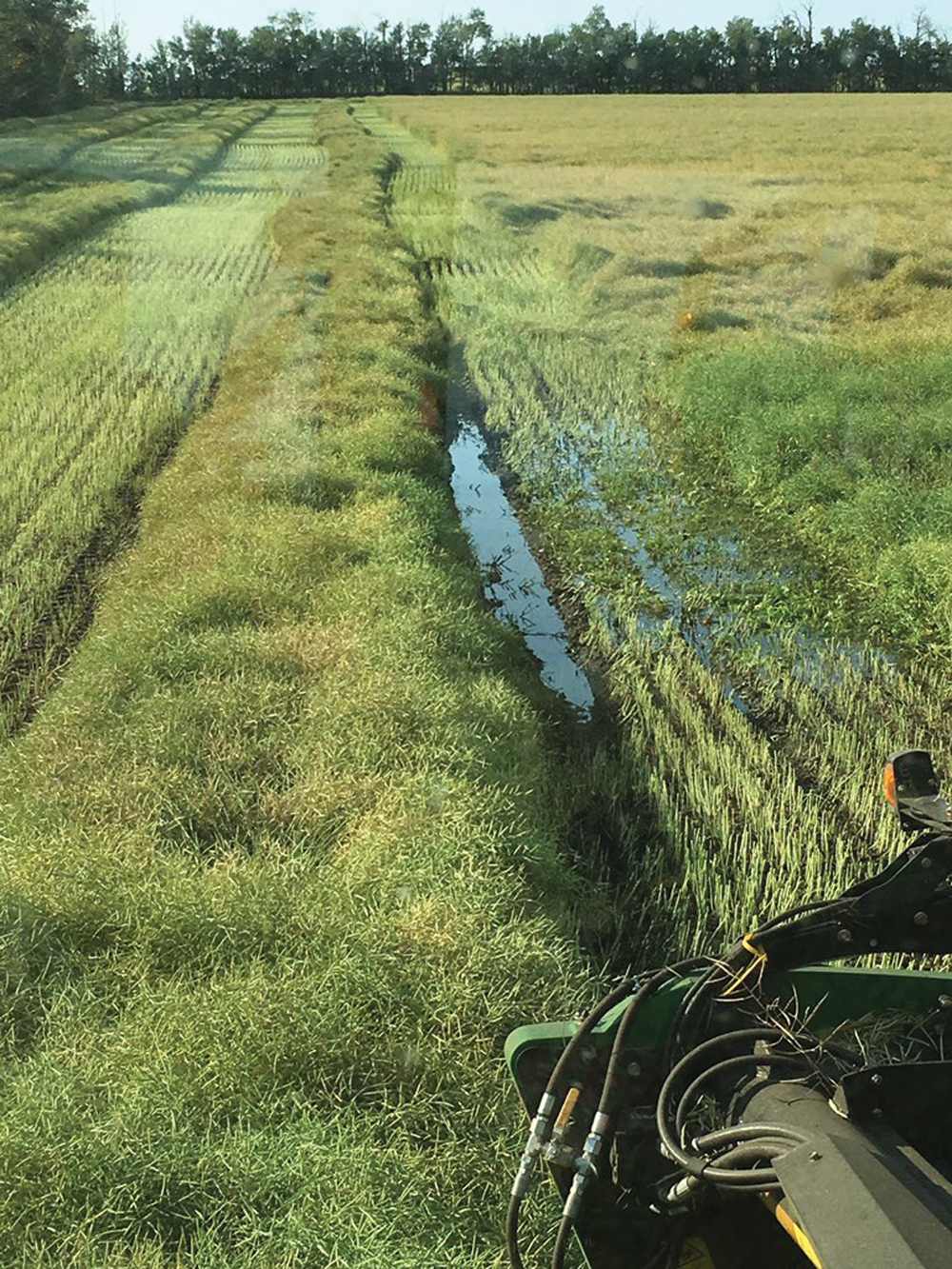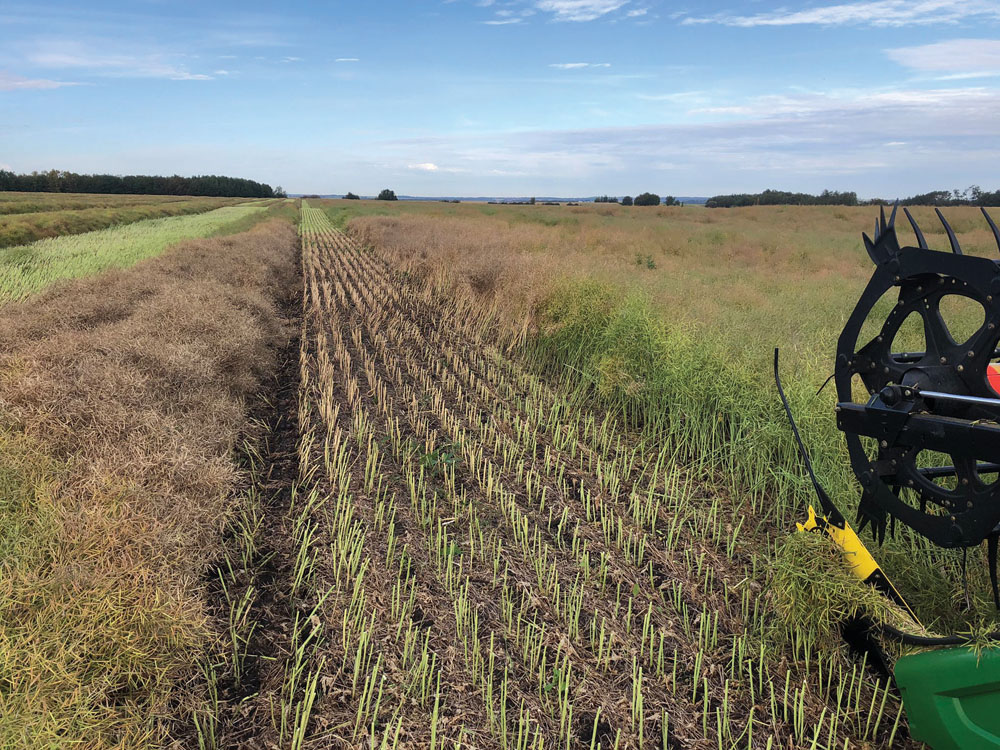The rain started falling in the middle of the night on Aug. 22, dumping two inches of water on John Guelly’s mature crops in less than 12 hours.
And then the storm started.

“I thought we had the worst of it, and then it ratcheted itself up. We ended up getting almost seven inches in about 32 hours,” said Guelly, who grows barley, wheat, and canola near Westlock.
“Around the fourth or fifth inch, all the water started running off the land and through the creek system, backing up the culverts just like in spring.
“We’ve never seen this before. This has got to be a one-in-50-year rain event at this time of the year.”
The flooding receded a day later but by then, the damage was done.
“I got some malt barley off last week, but with what’s left, I think malt is definitely out of the question,” Guelly said in an interview Aug. 25. “I’m worried that even the standing barley is going to start sprouting if we keep with this kind of moisture.”
It’s the same story for wheat, with hopes for a high-protein, high-quality crop washed away. Guelly is now hoping his canola, which fared OK despite some lodging, will pull him through what could be a tough marketing year.
“That’s one good thing about canola — weather doesn’t typically affect your grade so much at this time of year.”

Discounts widening
Selling a glut of lower-quality grain is going to be “a little bit of a grind” for farmers this fall and winter, said FarmLink’s senior market analyst Jonathon Driedger.
“You go into the growing season with expectations that it will be ‘normal,’ so when you get into a year like this where quality is very variable, that can really throw a wrench into the plans from a marketing perspective,” said Driedger.
“When you have quality issues on a potentially widespread scale, like what we’re looking at this year, it’s a little more challenging to find a home for the off-grade grain when there’s a lot of it. It typically moves a little slower, buyers have more challenges handling it, and the whole thing really becomes a lot more cumbersome for growers.”
Read Also

Farming Smarter receives financial boost from Alberta government for potato research
Farming Smarter near Lethbridge got a boost to its research equipment, thanks to the Alberta government’s increase in funding for research associations.
And for many growers, that could mean heavy discounts when it comes time to market their downgraded crop.
“If someone forward sold a No. 1 durum or No. 1 wheat and they end up growing a No. 3, depending on the grade discounts at the time, it can be really, really painful for growers,” said Driedger. “Typically in a year where there’s a lot of quality issues, those discounts only widen.”
The markets are starting to show some of that already, said Neil Blue, crop market analyst with Alberta Agriculture and Forestry.
“I’ve noticed that the price for malting barley has increased a bit in the last couple of weeks, and I believe that relates to the concerns about the possible downgrading of some of the malt crops out there,” Blue said in an interview Aug. 29.
The protein spreads on high-quality milling wheat have also increased, Blue added.
“They were down to about one cent per one-tenth of a point of protein, and now they’re three cents for every one-tenth of a point of protein,” he said. “That could also relate to concerns about wheat protein levels being relatively low this year compared to last year when we had a fairly high-protein wheat crop.”
But on the other hand, producers who manage to get a good crop off could see decent premiums at the elevator despite “sluggish” prices, said Driedger.
“In a year when quality grain is relatively short, that should help for farmers who were able to harvest better quality,” he said. “It should be easier getting movement opportunities. You maybe get a little more negotiating power at the elevator if quality is in shorter supply.”
Sell now or wait for spikes?
So should producers who get a good crop off strike while the iron is hot, or wait and hope premiums continue their climb?
That depends, said Driedger.
“I’d be reluctant to say across the board, ‘Hang on to it for dear life,’ or, ‘Blow it out.’ It’s really going to vary from one farm to the next and one crop to the next,” he said.
Premiums do tend to improve as the year goes on when quality grain is short, he said, but “there might be some great opportunities in the shorter term, too.
“You may, for example, have elevators that aren’t able to source the quality that they want in their backyard, have commitments to meet, and trains showing up,” he said. “It might be possible that there are some opportunities in the shorter term as well.”
Producers also need to consider their cash flow when deciding whether to off-load their high-quality grain, Blue added.
“It depends on what they have for cash flow needs and what their ideas are about the individual crops that they have to market,” he said. “It might be a good idea to hold on to at least some of that higher-quality crop, if not all of it, and see what the market does.”
Producers will need to stay “dialled in to what’s going on with those premiums and grade spreads” if they want to take advantage of price spikes, added Driedger.
“Make sure that you’re aware of what various buyers in your normal marketing range are paying, and maybe expand the scope of buyers you might ordinarily talk to,” he said. “Often in a year where there’s more lower-quality grain, you do see premiums and discounts widen, but they can also be really variable from one buyer to the next.”
Blue agrees.
“I think the most important thing is to shop around widely for outlets for that grain,” he said.
“That amounts to probably quite a bit of phone call work, but if one buyer doesn’t want that grain, perhaps there’s another buyer out there who has a slightly different use for it.
“There are markets out there for poorer-quality grain, and I think it’s important that producers take the time to shop widely for outlets for their grain.”
Farmers should always shop their grain around, said Driedger — but that’s even more important in a year when quality is variable.
“It’s a lot more work and a lot harder work marketing in a year like this, but in a lot of cases, that extra effort can pay off.”















